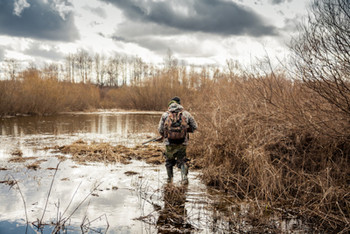Wilderness Survival Essentials: The Best Tactical Knife, Gear and More
Aug 28th 2018
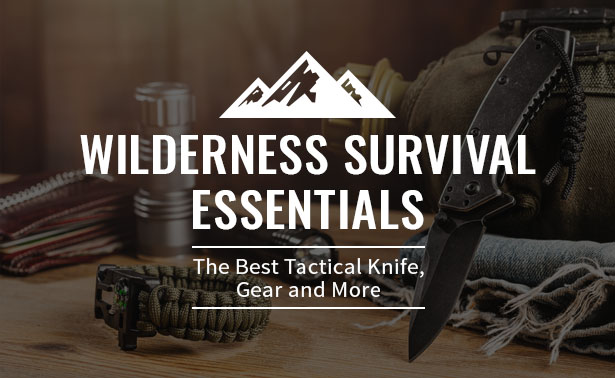
If you are an avid nature enthusiast and find yourself hiking or camping often, you should always know some basic survival essentials and carry tools with you in case of an emergency. Even if you don't go into the wilderness regularly, you never know when having this kind of knowledge could save you and your family's life. Whether you are looking for the best tactical knife to keep on-hand for your next hike, how to find or filter clean water or how to build a basic shelter, these are all skills and tools that will make a huge difference in your chances of survival in the great outdoors.
There is even a survival niche for the prepper market, and it's been bolstered by wildly popular dystopian and post-apocalyptic TV shows and movies. People who may not have thought much about being prepared for a natural disaster or zombie invasion are encouraged to seek out the basics to prepare for a worst-case scenario. Whether you camp often, or if you're getting ready for doomsday, there are certain survival basics you should learn and tools you should pick up before you come face-to-face with the wilderness.
HAVE A PLAN AND SHARE THAT PLAN
Whether you're going out for a short hike or heading out camping for a long weekend, you should always have a planned route. Planning your route ahead of time means that you can get a sense of the layout of the land, along with any major landmarks that can help guide you if you get lost.

You should also share this planned route with at least one other person. If you're hurt or seriously lost, someone will know you've been gone for too long and will alert authorities to begin searching for you. If that person has your route available, it's an excellent starting point for search parties.
There are also various technologies that can help you share your route with others. Some smartphone apps allow you to share your route, check in with loved ones and download maps for use offline. The GPS on your phone integrates with some of these apps to give your real-time location to those whom you've shared your route with. There are even apps that will crowdsource where a cell signal is working so that you can head in that direction to call for help.
If you're going to be in an area without cell coverage and you don't have a satellite phone, consider renting or buying a personal locator beacon (PLB) or a satellite messenger. A PLB works by sending out a distress signal which local search-and-rescue services can use to pinpoint your exact location. It should be activated in life-or-death situations only.
A satellite messenger device can send out a distress signal, or you can use it to communicate with emergency teams and friends and family. Popular devices like The SPOT messenger send out updates to friends and family with your GPS position and the ability to track your progress on Google Maps.

PREPARE FOR THE UNKNOWN WITH A TACTICAL KNIFE
One of the primary tools in your survival toolbox should be a good tactical knife. A knife can wear many hats in the wilderness, such as a self-defense weapon, fire-starting tool, cutting instrument or even a means to dig.
Because your knife might take a beating while you're out in the wilderness, invest in a knife with a sturdy blade, excellent cutting power and a point that will hold up under pressure. Utility knives, including those with extra tools on them such as screwdrivers and scissors, are also an excellent choice for survival situations.
Many enthusiasts recommend fixed-blade knives as the knife of choice for wilderness survival. While you can choose your blade style, a double-edged blade like the Borka Blade SBD is especially useful for wilderness and survival tasks.
Of course, a good folding knife is another option, and many preppers recommend carrying a folding knife for everyday carry (EDC) and survival tasks. The convenience of being able to fold the blade up and keep it safe in your pocket also means you’re less likely to lose it. There are plenty of folding knives that lock when they’re extended, making them just as sturdy as fixed-blade knives. The Kershaw Blur is a sturdy and dependable folding knife choice, and it’s ambidextrous.
Out-the-front (OTF) knives are also a great choice. Microtech Ultratech knives are OTF knives with a smooth thumb deployment mechanism you can depend on every time. What's interesting about these knives is that they also come with a glass-breaker in case you find yourself trapped in a car and need to break a window or windshield to escape. Since the knife comes with a handy belt clip, you can carry your knife with you wherever you go in states where OTF knives are legal.
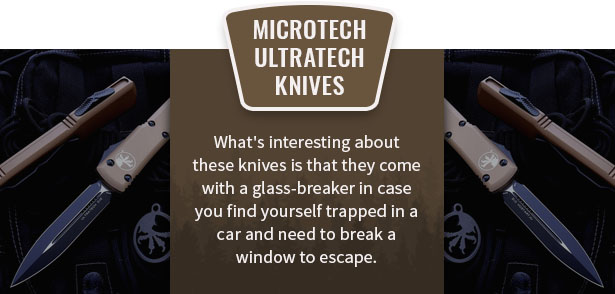
Ultimately, the best tactical knife for your survival needs will be the one that can multitask in different areas.
WHY HAVING A TACTICAL KNIFE IN THE WILD IS CRUCIAL
You may need your knife to cut through things, including rope, bandages, sticks, foliage and other items you need to open or cut out of the way. In some scenarios, you may even need to dig with your knife, especially if you don't have another tool for the job. Whether you're trying to get around a root, digging a latrine, excavating a fire pit or scavenging for worms to fish with, your knife can be an excellent tool to use in place of a shovel.
If you're hunting and cooking, your knife may play double-duty as a weapon and a kitchen utensil. For hunting small game, your knife can be incredibly useful when used properly at the end of a long stick as a spear. Once you've caught and killed your game, you can use the knife to skin and prepare it for cooking.
You can also use your knife as a substitute hammer. If you need to pound tent poles or pegs into the ground, or if you're putting together a makeshift shelter, your knife can stand in for your hammer to make sure items are secured.
Finally, your knife will always be a self-defense tool. Whether you carry a shotgun or concealed carry pistol with you when you hike or camp, having a knife nearby is always an excellent way to defend yourself against predators, both two- and four-legged. There are also specialized folding self-defense knives that work well for survival in urban and wilderness environments. The Combat Karambit by Emerson Knives is a particularly imposing folding knife with a hawkbill blade that will help you defend yourself properly.
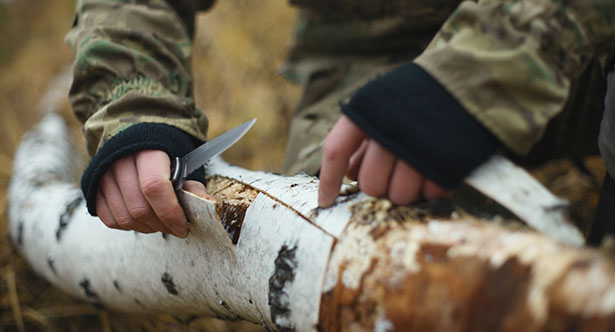
OTHER ESSENTIAL SURVIVAL GEAR
There are essential pieces of survival gear you should always carry with you when you're headed out into the woods or desert, so you can be prepared for most situations. In this section, we cover some of the basic necessities for wilderness survival.
- Rope/Cordage: Rope and cordage include rope, parachute cording, nylon string and even flexible metal wire. This is a useful tool for a variety of functions, including fishing, lashing poles, food and clotheslines, building shelter and climbing. You should have at least 10 feet of cordage in your pack at all times.
- Tactical Backpack: To carry all your gear, invest in a tactical backpack which is durable for all situations. Your backpack should have chest and waist straps to help distribute weight evenly as you're hiking, and it should be large and sturdy enough to carry up to 50 pounds of gear.
Your tactical backpack should also be waterproof, so you can rest assured your gear will remain dry, even if you encounter rain or have to cross a river. Bring along a plastic, waterproof case for your phone and other electronic gear for added protection.
- First Aid Kit: If you sprain or break your ankle, cut yourself or need to stop the bleeding quickly, a first aid kit will help protect the injured area and prevent infection until you can seek out medical attention. Your first aid kit should include items such as:
- Gauze and tape
- Bandages
- Gloves
- Alcohol wipes
- Insect repellent and anti-itch sprays
- Aloe Vera for sunburns
- Moleskin for blister treatments
- Antibiotic ointment
- Pain medication
- Tweezers
- Small mirror
- Small scissors
- Safety pins
You can shop for first aid kits that include all these items and more, or you can build your own, depending on how many people will be on the trip and how long you will be away. Additionally, if you are allergic to bees or other animal bites, your EpiPen should also be carried in your first aid kit.

- Flashlight: If you find yourself in the dark, a good flashlight can be invaluable. LED flashlights use battery power more efficiently and light up a dark area. Many tactical flashlights are small but output up to 600 lumens of pure light power. Other LED flashlights come with adjustable zoom so that you can widen or pinpoint your light in an area. These are particularly useful for signal lighting for Morse code. The small pinpoint beam can reach distances up to 150 meters.
Some hikers bring along a headlamp for added lighting power, especially if they will be exploring caves or other dark natural features in the landscape.
- Water Filtration Straw: If you're hiking and moving around a lot, you will be expending a lot of energy. While a person can go for several days without food, they cannot function for more than 72 hours without water. When you couple that factor with sweat, energy and lots of physical activity, you'll be consuming at least a gallon of water per day.
If you're going on a short trip, you likely won't have to worry too much about ensuring that you have enough water with you as you hike. For longer trips, however, finding a clean water source can be a challenge.
For a small amount of money, the LifeStraw is a worthwhile investment. It's something you should keep with you at all times for survival situations, and it should go with you on every hiking or camping trip. The LifeStraw removes parasites and bacteria from any water source, allowing you to drink water from virtually anywhere.
The LifeStraw will last for 1,000 gallons of water, and it is so small you can easily take it with you anywhere. LifeStraw also offers their filters to fit into your favorite water bottle, so you don't have to stoop down and use the straw directly from the stream or pond.

- Fire Starter: Even the best Boy or Girl Scout has had some trouble getting a proper fire started with sticks and rocks. If you're stuck in the woods and it's cold, or wild animals are getting too close, a fire may be the key to your survival throughout the night. It's also important if you're going to cook, especially if you're cooking the meat you've hunted.
Your fire starters should be kept in waterproof containers in your tactical backpack. A lighter, fire-starting aid and matches will be enough to cover your bases in case you have trouble starting a fire with one of them.
- Change of Clothes: If you get caught out in the elements and it's cold, it's important to have a change of dry clothes to help you warm up and avoid dangers such as hypothermia. If you've been sweating a lot, it's also essential to have a change of clothes because moisture will pull heat away from the body.
Carry an extra few pairs of socks in case your feet get wet. Wet feet in shoes can lead to blisters and other painful sores, and it can compromise your footing. If you have room in your backpack, consider bringing an extra pair of running shoes or hiking boots.
- Compass: Bring a compass with you and know how to use it. Your compass will help you with which direction you need to head in if you get lost and where your bearings are on a map.
HOW TO SURVIVE IN THE WILD
If you find yourself in a situation where you are unable to communicate with the outside world, and you need to survive in the wilderness, the first thing you must do is take a few breaths and stop the panic. Consciously slow yourself down so that you can think clearly and act purposefully. Panicking puts your life at risk, while careful thought may help save your life.
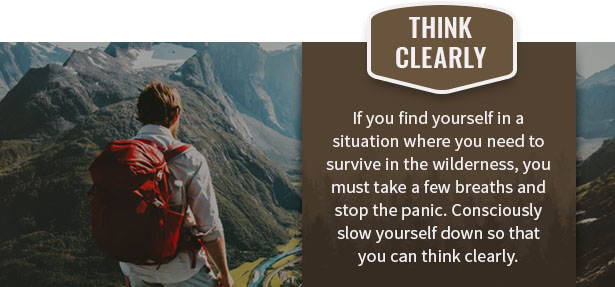
Build a shelter from whatever you can find, or with an emergency shelter kit in your pack. You should place it somewhere away from the wind and preferably against a natural feature such as a rock or the side of a cliff, so you don't have to worry about something sneaking up behind you.
Find a water source and use your survival water straw. Then, build a fire to keep warm. Have your best tactical knife on-hand to ward off any predators and to help you prepare dinner or build your shelter. Buckle down and survive the night and use your compass and maps to set out again the following morning.
FINAL THOUGHTS
With proper planning and survival gear, you can overcome the elements and survive in the wilderness. Keep your wits about you and don't panic if you find yourself lost or hurt. Utilize the tools you've brought with you to alert rescuers of your location and return to your home safely.

